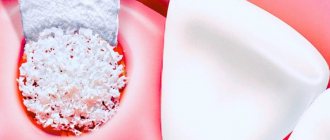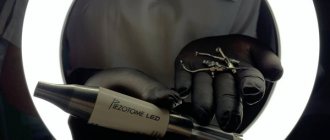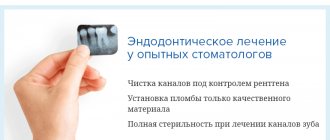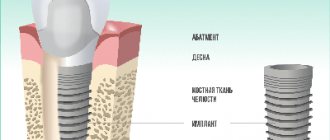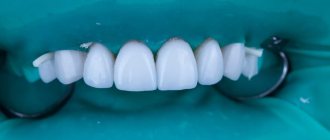In orthodontics, special rings are sometimes used. In another way they are called crowns. Is there a need to install them and what harm can they cause to the oral cavity? More on that later in the article.
Crowns in the field of orthodontics began to be used earlier than braces. The first medical devices of this type consisted of crowns, with pipes and hooks of guiding properties soldered to them. Through them, rubber rods were attached to the teeth. And the rods themselves moved the teeth in a given direction. However, the results of the doctors’ manipulations turned out to be not the most ideal, if not completely disastrous.
Crowns began to be used because there is no such material that would completely stick to the oral cavity. During the cementing process, various substances of rather low quality were used. The disadvantages included difficult teeth closing, which prevented patients from chewing food comfortably. The doctors tried cutting off the top part of the crowns. Thus, orthodontic rings were introduced into medical practice. They were fixed with cement. Such designs improved the functionality of the dentition; the rings did not interfere with the patient’s normal chewing.
Nowadays, it is possible to see such units, where the hooks were soldered, only in ancient textbooks. But such simple manipulations are still taught to students in specialized medical institutions. Now orthodontists install braces, the treatment process has become more advanced.
Pros and cons of treatment using rings
| Click to sign up for a FREE consultation |
The advantages include the following indicators:
- When installed, the risk of the bracket coming off is reduced.
- Rings reduce the risk of developing caries.
- The advantage is the possibility of using extraoral equipment, since the crown is fixed to the tooth.
The disadvantages of treatment when using rings include a large number of medical manipulations to install the rings and the need to remove them after the end of the treatment process.
Important: the doctor must carefully select rings to avoid the formation of inflammatory processes in the oral cavity.
Orthodontic treatment with braces
Orthodontic correction of malocclusion with braces includes the braces treatment itself and the retention period. During the active orthodontic period of treatment, pressure is constantly applied to the ligaments surrounding the tooth in different directions. This often causes patients to experience discomfort and pain, and sometimes itching. This is the reaction of the ligamentous apparatus of the tooth - the periodontium. The ligaments surrounding the tooth are stretched. Therefore, in order not to cause harm and lead to periodontal destruction, it is necessary to work with small but stable forces. Self-ligating braces do this job very well. After active orthodontic treatment, when the braces have already been removed, passive orthodontic treatment begins - retention, or strengthening and stabilization of the achieved result.
Retention period . The doctor records the result using a non-removable retainer for the central teeth, and in the laboratory, mouth guards are made based on your impression for night mode. The purpose of the retention period is to stabilize the ligamentous apparatus of the tooth in the resulting result. The tooth is entwined with a huge number of varieties of ligaments consisting of their fibers. And all these threads must be fixed in a new position. The ligaments that were stretched during the period of movement begin to grow into the new position of the tooth. This period lasts for years. Therefore, tooth mobility in the first year is normal. The entire ligamentous apparatus of the teeth is updated and adapted. Therefore, during this period, a non-removable retainer and a removable night guard are so necessary. To avoid relapse and not cause harm to teeth and ligaments, as well as to avoid repeated long-term treatment, the patient and the doctor must understand the responsibility of this period. Visit your doctor on time and do not remove retainers unless indicated. Retention can last from three years to a lifelong need for a permanent retainer. Whereas the average period of bite damage with a brace system is 1.5 years. The duration of the retention period is determined by the doctor.
Historical reference
The most famous device used in orthodontics is braces. However, separation rings began to be used much earlier, at the beginning of the last century, and for several decades remained a priority correction option. Their installation made it possible to forcibly change the position of molars or premolars, restoring the functionality and aesthetics of the dentition.
From a technical point of view, the first models of devices resembled artificial crowns, the dimensions of which were changed using a screw-like mechanism. The design was supplemented by guide elements, which were clasps and tubes through which a rubber rod was passed, exerting the necessary pressure on the teeth. However, the duration of such treatment was impossible to predict, as well as the resulting effect.
A breakthrough in technology was the possibility of creating crowns that replicate the anatomical structure and take into account the parameters of the elements of the dentition. It has become possible to install fixed structures on the entire jaw, fixing them with forceps and sealing the seam from the lingual side. However, this technique caused patients significant discomfort, associated both with the inconvenience of installation and with long adaptation after it. The situation improved slightly with the advent of composite material, but the inability to fully close the jaws continued to be the main complaint about such devices. The logical solution was to remove the upper part of the crowns, as a result of which their shape began to resemble rings, and patients were able to perform their usual chewing actions.
Modern separation rings are an element included in the structure of braces, placed on certain elements of the dentition.
Preparation
Installation of orthodontic bands will require at least two visits to the dentist. To fit a crown onto a tooth, it is necessary to create a small space between the units. It is formed by wearing rubber separation rings.
When inserted into the space between the teeth, the elastic material of the ring becomes denser. Over time, due to the physical characteristics of rubber, the thickness of the ring is gradually restored, pushing the dental units apart.
Spacer rings are placed between the tooth requiring adjustment and adjacent units. After a week of wearing, the distance between them will be sufficient for rings or crowns with a thickness of 0.2 mm.
When installing intracavitary braces, separators are not used.
Devices for advancing the lower jaw
In orthodontic practice, distal occlusion is one of the most common problems (more than 50%).
Distal occlusion is one of the most common diagnoses in Russia and other European countries. This is a type of closure of the dentition when the lower jaw is located posterior to the upper jaw. There can be four reasons for this: either the small size of the lower jaw, or its posterior location, or the too large size of the upper jaw and its anterior position.
Since we are talking about devices that advance the lower jaw, they are used precisely in those cases when problems concern the lower jaw.
It is most effective to use such devices during periods of active growth; in this case, we can achieve two effects at once: stimulation of jaw growth and advancement.
Kinds
Apparatuses that advance the lower jaw can be divided into those that are fixed on rings to the teeth until all permanent teeth have erupted - these are the Herbst apparatus and the non-removable telescopic apparatus (FNTA) - a domestic modification of the Herbst apparatus.
Another group includes devices that are fixed to the arches already during treatment with a brace system: the Jusper Jumper device, Twin BLock Bite Corrector, etc.
It can be added that if there are skeletal problems in the formation of the dentofacial system, the sooner you start orthodontic treatment using fixed appliances, the better the result can be obtained.
| Children's dentistry | |
| Prevention | |
| Professional oral and dental hygiene for children under 14 years of age | 3000 |
| School of psychological prevention for patients and relatives (adaptive reception) | 1000 |
| Sealing the tooth fissure with sealant | 2000 |
| Restoring a temporary tooth with a filling | |
| Restoring a tooth with a temporary filling using an isolation system | 3500 |
| Applying a temporary filling | 200 |
| Treatment of caries complications in primary teeth (endodontic root canal treatment) | |
| Application of devitalizing paste | 300 |
| Pulp extirpation | 600 |
| Pulpotomy (amputation of the coronal pulp) of a temporary tooth | 2600 |
| Instrumental and medicinal root canal treatment | 850 |
| Instrumental and medicinal treatment of a well-passable root canal | 850 |
| Filling the root canal of a tooth | 500 |
| Filling the root canal of a tooth | 2000 |
| Temporary filling of the root canal with a drug | 400 |
| Treatment with fixed orthodontic devices | |
| Manufacturing of an apparatus for distalization of molars on the upper jaw (Pendulum apparatus) | 31000 |
| Manufacturing of an apparatus for rapid palatal expansion (Haas, RME, Nord apparatus) | 33000 |
| Palatal clasp | 20000 |
| Manufacturing and fixation of Mesial Jet, Distal Jet devices | 41000 |
| Fitting and installation of the apparatus for advancing the lower jaw (Twin Force Bite Correktor) | 45000 |
| Ring with spacer (for one tooth) | 5000 |
| Tongue flap (fixation with rings) | 16000 |
| Making an orthodontic ring | 5000 |
General information
Initially, orthodontic rings were placed on each tooth. A metal arc was pulled through structures equipped with grooves and hooks. As a result of the treatment, the teeth were straightened, but after the rings were removed, gaps (three spaces) remained between them.
With the advent of braces made of composite materials, the process of correcting bites has become significantly easier. However, to straighten molars, metal rings are used that can withstand greater loads than the polymer plates of brackets.
When installing braces, rings with a soldered lock are fixed on the 6th, 7th and 8th units using fluoride adhesive. They are used in cases where it is impossible to put a lock on the enamel (large filling, artificial crown).
Installation
The inner surface of the ring has grooves that increase the adhesion strength to dental glue. On the outside of the ring there is a bracket with two grooves and a hook. For each dental unit there is a separate element, on which there is a corresponding marking with the size.
The crowns are attached using dental adhesive (cement), which seals the small gap between the unit and the steel wall of the device. When the procedure is carried out correctly, patients’ teeth are reliably protected from external factors.
Orthodontic crowns have fundamental differences from crowns used in dental prosthetics. When installing them, there is no need to grind teeth, prepare enamel or other operations that cause inconvenience and discomfort.
Advantages
The advantages of installing orthodontic rings have been noted by both orthodontists and patients:
1. When any of the braces plates come off, treatment slows down. This is due to the fact that the dental unit, not restrained by anything, moves in the wrong direction. In this case, the treatment steps will need to be repeated. When installing crowns, the likelihood of the plates coming off is reduced.
2. It is more difficult for a patient with braces to take care of the oral cavity. The doctor is especially concerned about the hygiene of chewing teeth. When installing crowns, the units will be protected from external influences and the risk of caries.
3. If it is necessary to install corrective structures outside the oral cavity (for example, a face bow), orthodontic rings are elements of its fastening. Thanks to the strong fastening and a special groove, the external device is installed securely.
Flaws
In addition to the time spent on additional manipulations, orthodontic crowns have the following disadvantages:
– after removing the elements, gaps remain between the teeth, which do not always close on their own. It is necessary to take additional measures to eliminate three;
– if the size is not selected correctly or the ring is not fitted professionally, dental diseases are likely, including inflammation of the periodontium and tooth;
– while wearing separation rings, they may penetrate into the gum tissue. The number of installed elements should be controlled by the dentist.
Benefits of use
Separation rings used in modern orthodontics are part of the bracket system design, placed, if necessary, on problematic units of the row. The need for installation is determined by the clinical picture - the technique allows you to obtain a number of advantages, which include:
- Increasing the reliability of braces fixation;
- Protecting teeth from negative influences;
- Creating conditions for using a facebow.
The list of cases in which the use of ring elements is recommended includes:
- Correction of abnormally developing occlusion in complex defects;
- Preparation for point or complex prosthetics;
- There is a need to stimulate the eruption and development of molars;
- Planning for implant integration.
For other clinical indications, alternative correction methods are usually recommended.
